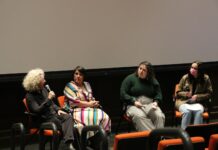Author: Natania Reed|Natania Reed
The Getty Center-sponsored Pacific Standard Time initiative, a collaboration between more than 60 art institutions across Southern California, celebrates the growth of Los Angeles’ art scene and its establishment as a center of artistic innovation between 1945 and 1980.
The project officially starts October 1, but several participating institutions have opened their doors early, including the Museum of Latin American Art, located in the East Village Arts district of Long Beach.
The Museum of Latin American Art unveiled “MEX/LA: ‘Mexican’ Modernism(s) in Los Angeles, 1930-1985,” on Sept. 18, an exhibit that examines the complex relationship between Mexican culture and the Los Angeles melting pot through modern, avant-garde artwork.
On display until Jan. 29, 2012, much of the work displayed showcases the interaction between pop culture, modernist traditions and traditional Mexican folk art.
“The exhibition, in a way, is like the city of Los Angeles itself,” the curator Ruben Ortiz-Torres said.
“Like a modern collage, it is a fragmented juxtaposition of simultaneous clashing and contesting representations and misrepresentations that do not quite integrate but talk to each other and together form a whole.”
Saturated with allusions to political and social issues, the exhibit does more than merely showcase significant pieces of art produced throughout this particular time period.
Ortiz-Torres selected pieces from an incredibly vast selection of artists, varying from filmmakers to photographers to experimental artists.
Numerous pieces are on display, for example, by Graciela Iturbide, a Mexican-born photographer who is best known for her images of the daily lives of Mexican-Americans in East Los Angeles.
Her photograph “Cholas, White Fence, East LA” (1986) captures four young women flashing gang signs while posing beneath a mural of former President of Mexico Benito Juarez, infamous revolutionary general Pancho Villa and Mexican Revolution figurehead Emiliano Zapata.
David Alfaro Siquerios’ mural “Mitin en la calle” (Street Meeting) documents a trade union militant addressing a multiracial audience, making more overt social commentary.
Harry Gamboa Jr., one of the founders of the Chicano performance art collective, ASCO, is also featured in the exhibit as well as the influential photographer Edward Weston, a Southern Californian who lived and created his most powerful work in Mexico. Weston’s famous portrait of Mexican painter Jose Clemente Orozco is featured at the exhibit and reflects the relationship between Mexican and American artists during this time period.
Martin Ramirez’ work of collages and drawings, which directly evinces pop culture’s intersection with high art forms, deals with Mexican folk traditions in a way influenced by twentieth-century modernism.
A large selection of Disney sketch artists is on display as well. In the ultimate portrayal of low/high art, however, the 1944 Disney film “The Three Cabelleros” plays among pieces by Weston and Siquerios.
Despite the cohesive execution and diverse selection of art, the exhibit lacks an adequate appraisal of the audience’s knowledge of the history behind the pieces on display.
The brief timeline of Latino history in L.A. outside the entrance to the building provides some context, but in retrospect, it would have been beneficial to have a more extensive knowledge of the Chicano experience in L.A. throughout the twentieth century in order to appreciate the complexity and multidimensional quality of the exhibit.
Many images reference specific incidents in Mexican history, without adequate explanation on the placard.
Consequently, the importance of the artwork might be lost on those who are uninformed about Los Angeles and Mexico’s tumultuous history.
For example, multiple pieces pay homage to the Zoot Suit Riots of 1943, when violence erupted between white sailors stationed in Los Angeles and Mexican youths.
Without sufficient background, much of the meaning is lost on the viewer.
If “MEX/LA” is any indication of the Pacific Standard Time exhibits to come, though, Los Angeles art enthusiasts can expect increasingly vibrant and important cultural milestones.
The works of “MEX/LA” portray the chaotic periods of Los Angeles’ past through the lens of social, political and racial analysis.
The art displayed is not only aesthetically interesting, but also culturally relevant, a theme to be continued throughout the remainder of the Pacific Standard Time initiative.
This article has been archived, for more requests please contact us via the support system.
![]()





































